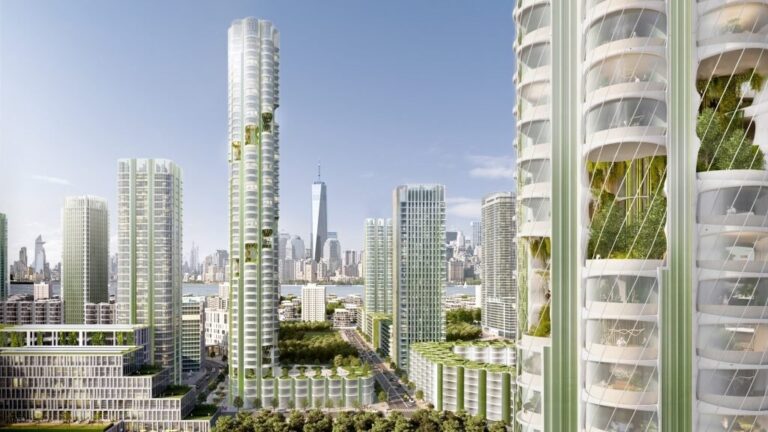Architects and engineers are looking for creative ways to tackle growing carbon dioxide (CO2) levels in urban environments as the globe struggles with the effects of climate change. The idea of the Urban Sequoia, a skyscraper made to absorb CO2, is one of these ground-breaking ideas.
This architectural masterpiece, which draws inspiration from the imposing redwood trees of California, intends to not only provide sustainable urban living. But also to help reduce greenhouse gas emissions. The Urban Sequoia’s concept, design, and potential advantages in changing sustainable building are all covered in this article.
Table of Contents
The design and structure
The Urban Sequoia’s design contains a number of cutting-edge elements to maximize carbon absorption. A network of vertical gardens that have been meticulously chosen for their capacity to sequester CO2 and adorn the building’s front. These living walls not only improve the building’s architectural appeal. But they also serve as natural air filters, enhancing the area’s air quality.
In addition, the Urban Sequoia produces renewable energy for its own operation by using cutting-edge technology including thin photovoltaic panels and wind turbines. The extra energy produced can be used to power nearby structures or fed back into the grid. Thus eliminating the need for fossil fuels and promoting a more sustainable energy environment.
The effective ventilation system of the structure is essential to its operation. It uses the CO2 gathered from the facade to feed and grow interior gardens, fostering coexistence between people and nature inside the structure. This technology gives residents a tranquil, natural environment in addition to improving the air quality.
The concept behind the Urban Sequoia skyscraper
Inspired by the mighty sequoia trees, Redwood trees, which are renowned for having a remarkable capacity to absorb and store enormous amounts of CO2, served as the model for the Urban Sequoia. These massive trees have the capacity to naturally store carbon, providing a model for builders to follow when creating environmentally responsible structures.
To replicate the redwood’s capacity to absorb CO2, this creative tower blends cutting-edge technology with biomimicry ideas. A facade made of specialized materials, such as concrete that absorbs carbon dioxide and panels packed with high-efficiency algae, adorns the building. By actively absorbing CO2 from the atmosphere, these substances serve as carbon sinks.
The benefits of the Urban Sequoia skyscraper
There are several environmental and social advantages to Urban Sequoia.
First and foremost, its capacity to absorb CO2 aids in mitigating the negative effects of greenhouse gas emissions. Thus lowering metropolitan areas’ carbon footprint. We may significantly advance our efforts to prevent climate change and achieve carbon neutrality by incorporating such structures into urban environments.
A greener and more sustainable urban lifestyle is promoted through the use of green areas, vertical gardens, and natural components in architectural design. The Urban Sequoia offers a haven of peace in densely crowded places. Which has a beneficial effect on mental health and wellbeing.
Additionally, the use of renewable energy sources lessens reliance on fossil fuels. Thus resulting in a cleaner and more environmentally friendly energy environment. The Urban Sequoia can act as a catalyst for sustainable urban growth by dispersing excess energy into neighboring structures.
Challenges of the urban sequoia concept
Although the Urban Sequoia concept has great potential, there are obstacles that must be solved before it can be put into practice. The scalability of the architecture is one major barrier. Skyscrapers that can absorb significant volumes of CO2 must be built with careful planning, advanced engineering skills, and cooperation from industry players.
Building towering structures that can absorb CO2 presents special structural integrity challenges. The building’s design must make sure that it can endure environmental conditions like wind loads and seismic activity. As well as the weight of the carbon-absorbing components. To guarantee the stability and safety of the construction, rigorous testing and simulations are necessary.
Technology development is crucial for the Urban Sequoia concept to be implemented successfully. Further study and development are needed to create and include effective carbon-absorbing materials like algae-filled panels and concrete that absorbs carbon. To develop affordable, sustainable solutions that can survive the challenges of urban environments, material scientists must work with architects, engineers, and other design professionals.
The Urban Sequoia’s long-term upkeep and operational effectiveness must also be a priority. To maintain the building’s performance and beauty, regular monitoring, repair of carbon-absorbing components, and upkeep of green spaces are necessary.
Additionally, the materials must be strong and resistant to deterioration, reducing the frequency of replacements and repairs.
Read also: Vertical forests around the world, extraordinary examples of sustainable architecture and design
The future of sustainable architecture
The Urban Sequoia is an excellent example of how environmentally important issues are solvable through sustainable construction. Adopting cutting-edge ideas like this skyscraper as our cities expand will assist us in building a future that is more robust and sustainable.
We are able to develop urban spaces that are not only aesthetically beautiful. But also actively fight climate change by fusing nature-inspired design, cutting-edge technology, and renewable energy systems. The Urban Sequoia represents a significant advancement in the quest for sustainable urban living. And ushers in a new era of architecture that complements nature.
To overcome the difficulties the Urban Sequoia concept has, there is the need of more materials science research and development. New materials and methods that improve carbon absorption capacity, durability and energy efficiency can be investigated by scientists and engineers. Future versions of the Urban Sequoia could cut CO2 emissions even more effectively by utilizing developments in nanotechnology, bio-inspired materials, and carbon capture technologies.
Read also: Urban greenery: how planting trees will save cities from rising temperatures












